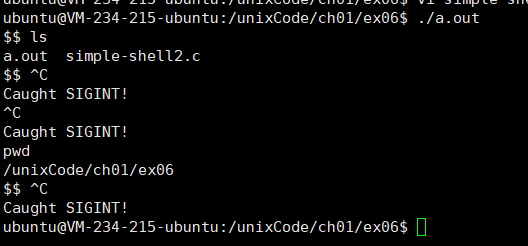Unix学习笔记(一)
1. welcome.c
源码:
#include
#include
int main(int argc, char **argv) {
printf("Welcome to CS631 Advanced Programming in the UNIX Environment, %s!\n", getlogin());
} 输出:
函数解析:
getlogin()
如果有的话,这个函数返回当前登录名。在 Unix 系统上,它是从 utmp(5) 文件里读取的。如果它返回假,那么用 getpwuid 取代。
补充说明:
需要说明的是,utmp文件是二进制文件,在命令行,我们需要用who,w,users等命令访问utmp中的内容。
可以看到,当前只有一个用户ubuntu登陆。
问题:
在linux下以ubuntu用户名登陆,之后使用su命令切换用户,但显示的用户名始终不变。
2. combine.c
源码:
#include
int main(){
int i=8,j;
__asm__ ("movl %1,%0" : "=r" (j) : "m" (i));
printf("%d\n",j);
} 输出:
函数详解:
这是gcc内嵌汇编语言的写法,从输出结果我们可以看出,这一段汇编的含义是将i赋值给j。
补充说明:
关于汇编使用gcc -S combine.c 可以生成中间的汇编代码combine.s文件。可以通过vim查看一下combine.s
3. simple-ls.c
源码:
/*
* simple-ls.c
* Extremely low-power ls clone.
* ./simple-ls .
*/
#include
#include
#include
#include
int
main(int argc, char **argv) {
DIR *dp;
struct dirent *dirp;
if (argc != 2) {
fprintf(stderr, "usage: %s dir_name\n", argv[0]);
exit(1);
}
if ((dp = opendir(argv[1])) == NULL ) {
fprintf(stderr, "can't open '%s'\n", argv[1]);
exit(1);
}
while ((dirp = readdir(dp)) != NULL )
printf("%s\n", dirp->d_name);
closedir(dp);
return(0);
} 输出:
函数详解:
(1) DIR* opendir(const char* path)
获取path子目录下所有文件和文件夹的列表,如果path是一个文件,则返回NULL。
(2) struct dirent* readdir(DIR* dir_handle)
如果有未读取的目录项,返回dirent结构体指针,如果全部读完,则返回NULL。这个结构体的内容如下:
struct dirent
{
long d_ino; /* inode number 索引节点号 */
off_t d_off; /* offset to this dirent 在目录文件中的偏移 */
unsigned short d_reclen; /* length of this d_name 文件名长 */
unsigned char d_type; /* the type of d_name 文件类型 */
char d_name [NAME_MAX+1]; /* file name (null-terminated) 文件名,最长255字符 */
}(3) int closedir(DIR * dir_handle)
关闭打开的目录。
补充说明:
整个代码的逻辑如下:
首先检查参数个数,如果参数个数不对提醒用户这个函数的用法。如果参数正确,则用opendir()检查目标目录是否真的为目录,如果不是则报错。如果是,则通过readdir()一个个读取文件夹下的文件名(上文输出中的.代表当前目录,..代表父目录)。最后通过closedir()关闭文件。
4. simple-cat.c
源码:
/*
* Stripped down version of 'cat', using unbuffered I/O.
* ./simple-cat < simple-cat.c
*/
#include
#include
#include
#ifndef BUFFSIZE
#define BUFFSIZE 32768
#endif
int main(int argc, char **argv) {
int n;
char buf[BUFFSIZE];
while ((n = read(STDIN_FILENO, buf, BUFFSIZE)) > 0) {
if (write(STDOUT_FILENO, buf, n) != n) {
fprintf(stderr, "write error\n");
exit(1);
}
}
if (n < 0) {
fprintf(stderr, "read error\n");
exit(1);
}
return(0);
} 输出:
函数详解:
read()和write()是很重要的函数,这里只是讲解其中的一部分,其他的内容会在后面的代码中慢慢涉及。
ssize_t read(int filedes, void *buf, size_t nbytes)
read的函数的三个参数分别代表文件描述符,读取数据缓存区,要读取的数据字节数。
返回值:若成功返回读到的字节数,若已到文件末尾返回0,若出错则返回-1.
ssize_t write(int filedes, void *buf, size_t nbytes)
write的函数的三个参数分别代表文件描述符,要写入的数据缓存区,要写入的数据字节数。
返回值:若成功返回写入的字节数,若出错则返回-1。
int fprintf( FILE *stream, const char *format, ... )
fprintf()函数根据指定的format(格式)(格式)发送信息(参数)到由stream(流)指定的文件. fprintf()只能和printf()一样工作. fprintf()的返回值是输出的字符数,发生错误时返回一个负值.
补充说明:
read和write的文件描述符通常是通过open函数的返回值获得。在这个代码中使用STDIN_FILENO和STDOUT_FILENO来代表标准输入和标准输出,也就是在终端输入和输出。
整个程序最后实现的功能是从终端写入多少数据,就会从终端显示出多少数据。
5. simple-shell.c
源码:
#include
#include
#include
#include
#include
#include
#include
#include
char *
getinput(char *buffer, size_t buflen) {
printf("$$ ");
return fgets(buffer, buflen, stdin);
}
int
main(int argc, char **argv) {
char buf[1024];
pid_t pid;
int status;
while (getinput(buf, sizeof(buf))) {
buf[strlen(buf) - 1] = '\0';
if((pid=fork()) == -1) {
fprintf(stderr, "shell: can't fork: %s\n",
strerror(errno));
continue;
} else if (pid == 0) {
/* child */
execlp(buf, buf, (char *)0);
fprintf(stderr, "shell: couldn't exec %s: %s\n", buf,
strerror(errno));
exit(EX_DATAERR);
}
if ((pid=waitpid(pid, &status, 0)) < 0)
fprintf(stderr, "shell: waitpid error: %s\n",
strerror(errno));
}
exit(EX_OK);
} 输出:
函数详解:
这段代码的核心是用于进程控制的三个函数fork,exec,waitpid。(exec函数有7种变体,但经常把它们统称为exec函数)
(1) fgets函数从标准输入一次读取一行,当输入文件结束符(通常是Ctrl+D)作为行的第一个字符时,fgets返回一个null指针,于是循环停止,进程也终止。
(2) buf[strlen(buf) - 1] = '\0' 这行代码表示用null字节替换换行符。这样做是因为execlp函数要求的参数是以null结尾而不是以换行符结束的。
(3) 调用fork创建一个新进程。新进程是调用进程的一个副本。我们称调用进程为父进程,新创建的进程为子进程。fork对父进程返回新的子进程的进程ID(一个非负整数),对子进程则返回0。因为fork创建了一个新进程,所以说它被调用一次(由父进程),但返回两次(分别在子进程和父进程中)。
(4) int execlp(const char * file,const char * arg,……);
execlp()会从PATH 环境变量所指的目录中查找符合参数file的文件名, 找到后便执行该文件, 然后将第二个以后的参数当做该文件的argv[0]、argv[1]……, 最后一个参数必须用空指针(NULL)作结束。
(5) 子进程调用execlp以执行新程序文件,而父进程希望等待子进程终止,这是通过调用waitpid实现的,其参数指定要等待的进程,waitpid函数返回的是子进程的终止状态。在这个程序中并没有用到这个返回值。
补充说明:
至于在这个程序中为什么要fork一个新进程,原因是我们需要用这个子进程来拉起其他的进程(比如ls进程)。如果不创建这个子进程,则执行一条shell命令后程序就会终止,示例如下:
#include
#include
#include
#include
#include
#include
#include
#include
char * getinput(char *buffer, size_t buflen) {
printf("$$ ");
return fgets(buffer, buflen, stdin);
}
int main(int argc, char **argv) {
char buf[1024];
pid_t pid;
int status;
while (getinput(buf, sizeof(buf))) {
buf[strlen(buf) - 1] = '\0';
execlp(buf, buf, (char *)0);
fprintf(stderr, "shell: couldn't exec %s: %s\n", buf,
strerror(errno));
exit(EX_DATAERR);
}
exit(EX_OK);
}
6.simple-shell2.c
源码:
#include
#include
#include
#include
#include
#include
#include
#include
#include
static void sig_int(int);
char *
getinput(char *buffer, size_t buflen) {
printf("$$ ");
return fgets(buffer, buflen, stdin);
}
int
main(int argc, char **argv) {
char buf[1024];
pid_t pid;
int status;
if (signal(SIGINT, sig_int) == SIG_ERR) {
fprintf(stderr, "signal error: %s\n", strerror(errno));
exit(1);
}
while (getinput(buf, sizeof(buf))) {
buf[strlen(buf) - 1] = '\0';
if((pid=fork()) == -1) {
fprintf(stderr, "shell: can't fork: %s\n",
strerror(errno));
continue;
} else if (pid == 0) {
/* child */
execlp(buf, buf, (char *)0);
fprintf(stderr, "shell: couldn't exec %s: %s\n", buf,
strerror(errno));
exit(EX_DATAERR);
}
if ((pid=waitpid(pid, &status, 0)) < 0)
fprintf(stderr, "shell: waitpid error: %s\n",
strerror(errno));
}
exit(EX_OK);
}
void
sig_int(int signo) {
printf("\nCaught SIGINT!\n");
} 这一段代码和上一段代码几乎一样,只是多了一个signal机制。
输出:
函数详解:
signal(int sig,sighandler_t handler)
unix的系统调用signal()用于接受一个指定的信号,并可以指定相应的处理方法。
在上段代码中,指定的处理函数是下面的sing_int(int signo)。






